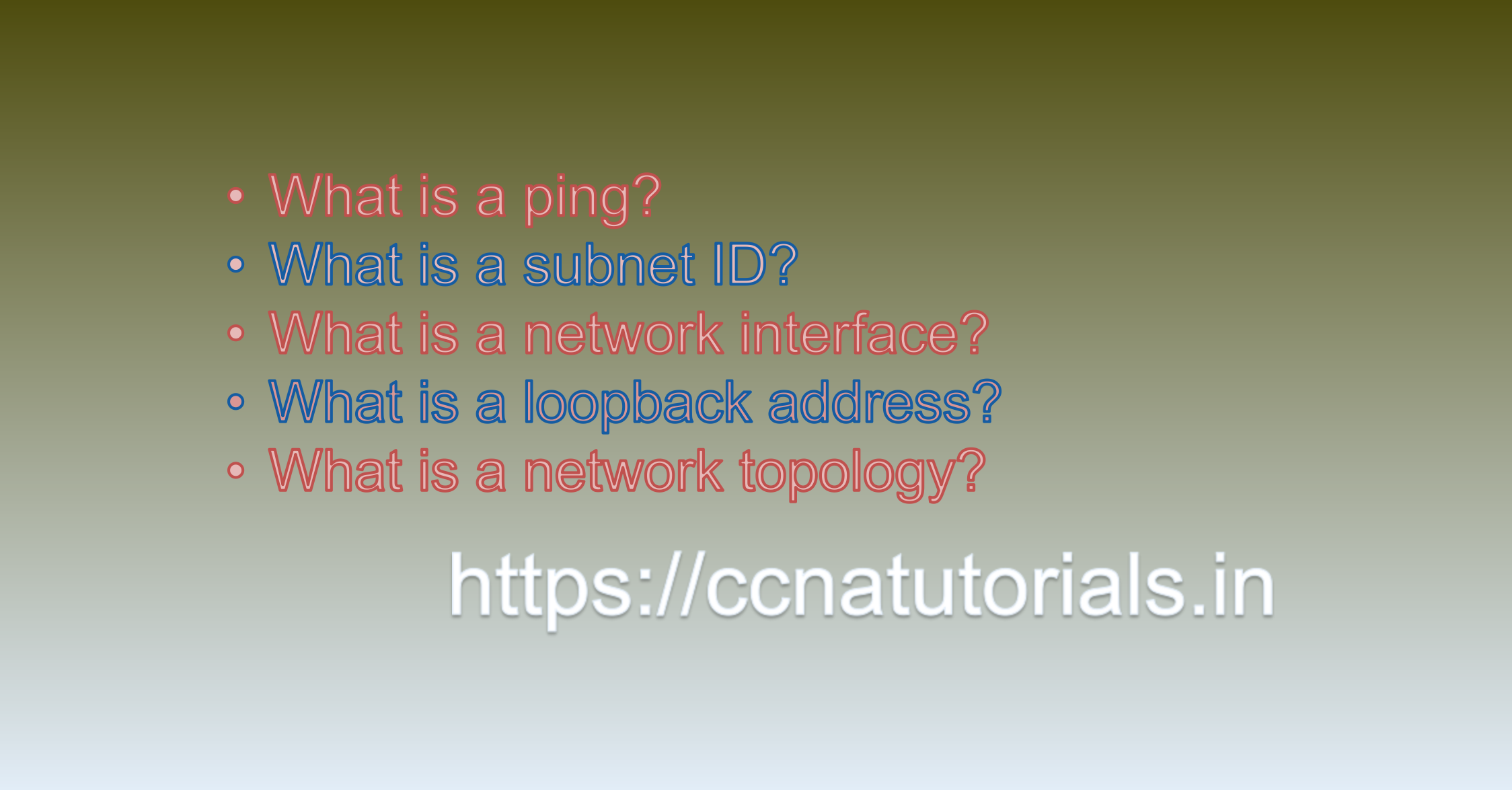Contents of this article
In this article, I describe some CCNA sample questions for practice before appearing in the CCNA 200-301 exam. The following questions are basic questions and related to the CCNA sample questions set 16. There are multiple sample questions set on this website for prior practice online. All questions are described with relevant answers. You can take the following questions and answer as reference for CCNA 200-301 exam. You may also need to do more practice with other websites and books to practice the CCNA sample questions set 16.
Question 1. What is a ping?
Ping is a basic network diagnostic tool used to test the reachability of a device on a network and measure its response time. The ping tool works by sending a series of ICMP (Internet Control Message Protocol) echo request packets to the target device and measuring the time it takes for the device to send back an ICMP echo reply packet.
The ping tool is commonly used to troubleshoot network connectivity issues, such as identifying devices that are offline or experiencing high latency. The tool can be used to test the connectivity of any device on a network that has an IP address, including servers, routers, and client devices.
Ping sends multiple echo request packets to the target device and reports the percentage of packets that were successfully received, as well as the round-trip time (RTT) for each packet. The RTT is the time it takes for an echo request packet to travel from the source device to the target device and back again.
Ping can also be used to measure network performance and detect network congestion. By sending a large number of echo request packets to a device, network administrators can measure the average response time and identify any packets that are lost due to network congestion or other issues.
Ping is a basic network diagnostic tool used to test the reachability of a device on a network and measure its response time. The tool works by sending ICMP echo request packets to the target device and measuring the time it takes for the device to send back an ICMP echo reply packet. Ping is commonly used to troubleshoot network connectivity issues and measure network performance. This is the answer to question 1 of CCNA sample questions set 16.
Question 2. What is a subnet ID?
A subnet ID is a part of an IP address that identifies a specific subnet on a network. A subnet is a logical subdivision of a larger network, and a subnet ID is used to differentiate between multiple subnets on the same network.
A subnet ID is created by taking a portion of the IP address and using it to represent the subnet. The number of bits used for the subnet ID can vary depending on the size of the network and the number of subnets required. The remaining bits in the IP address are used to identify individual devices on the subnet.
For example, in a Class C network (which uses a subnet mask of 255.255.255.0), the first three octets of the IP address are used to represent the network, while the final octet is used to identify individual devices. To create subnets within the network, some of the bits in the final octet are used for the subnet ID, while the remaining bits are used to identify devices on the subnet.
For instance, if we use 3 bits of the final octet for the subnet ID, we can create up to 8 subnets (2^3), each with a unique subnet ID. The remaining 5 bits can then be used to identify individual devices on each subnet, allowing for a total of up to 32 (2^5) devices per subnet.
A subnet ID is a part of an IP address that identifies a specific subnet on a network. It is created by taking a portion of the IP address and using it to represent the subnet. The subnet ID is used to differentiate between multiple subnets on the same network, while the remaining bits in the IP address are used to identify individual devices on the subnet. This is the answer to question 2 of CCNA sample questions set 16.
Question 3. What is a network interface?
A network interface is a hardware or software component that enables a device to connect to a network. It provides the physical or virtual connection between the device and the network, allowing data to be sent and received over the network.
A network interface can be a physical component, such as a network card (NIC) or Ethernet adapter, that connects a device to a wired or wireless network. It can also be a virtual component, such as a virtual network interface (VNIC), that is created by software to enable communication between virtual machines or containers on the same physical server.
The network interface is responsible for managing the communication between the device and the network. It handles tasks such as sending and receiving data packets, translating data into a format that can be transmitted over the network, and managing network connections and protocols.
Each network interface has a unique identifier, known as a Media Access Control (MAC) address, that is used to identify the device on the network. The network interface may also have its own configuration settings, such as IP address, subnet mask, and gateway address, which are used to control how the device communicates with other devices on the network.
In summary, a network interface is a hardware or software component that enables a device to connect to a network. It provides the physical or virtual connection between the device and the network, and is responsible for managing communication between the device and the network. This is the answer to question 3 of CCNA sample questions set 16.

Question 4. What is a loopback address?
A loopback address is a special IP address used to refer to the same device that is sending or receiving data. The loopback address is typically assigned the IP address 127.0.0.1 in IPv4 and ::1 in IPv6.
When a device sends data to its own loopback address, the data is not sent out over the network, but instead is routed back to the same device without being transmitted over any physical network interface. This allows the device to test network software and applications without having to transmit data over the network.
The loopback address is commonly used by network administrators and developers to test network services and applications running on a device. For example, a web developer can test a website running on a local web server by accessing it through the loopback address in a web browser.
In addition to testing, the loopback address can also be used for troubleshooting network connectivity issues. For example, a network administrator can use the ping utility to test connectivity by sending a ping request to the loopback address, which will verify that the network interface is working correctly and that the TCP/IP stack is properly configured. This is the answer to question 4 of CCNA sample questions set 16.
Question 5. What is a network topology?
A network topology refers to the physical or logical arrangement of devices, nodes, and connections in a computer network. It describes how the devices and nodes are connected and how they communicate with each other.
There are several different types of network topologies, including:
- 1. Bus topology: A bus topology consists of a single cable that connects all the devices in the network. Each device is connected to the cable through a T-connector.
- 2. Star topology: A star topology has a central device, such as a switch or hub, that connects all the devices in the network. Each device is connected to the central device through a separate cable.
- 3. Ring topology: A ring topology connects all the devices in the network in a circular ring. Each device is connected to the next device in the ring.
- 4. Mesh topology: A mesh topology connects each device in the network to every other device. This provides redundancy and fault tolerance in case of a connection failure.
- 5. Hybrid topology: A hybrid topology combines two or more of the above topologies to create a more complex network.
The choice of network topology depends on the specific needs of the network and the devices being used. Factors such as scalability, cost, reliability, and performance need to be considered when designing a network topology. This is the answer to question 5 of CCNA sample questions set 16.
Conclusion for CCNA sample questions set 16
In this article, I described 5 questions with answers related to CCNA 200-301 exam. I hope you found these questions helpful for the practice of the CCNA 200-301 exam. You may drop a comment below or contact us for any queries related to the above questions and answers for CCNA 200-301. Share the above questions If you found them useful. Happy reading!!






